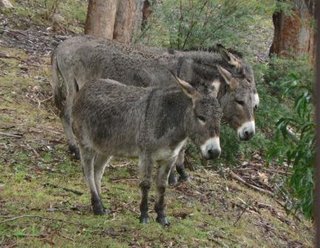The medlars were picked when they were ready to be picked, which means that they came off the tree easy as apples when they are ready. A little twist or a shake of the branches, and medlars come tumbling down. They bounce. They are easiest to gather (and find) if you check the ground for windfalls, and then spread an old sheet on the ground as you pick or shake. Medlars do fall to the ground without having bletted on the tree, but if you want them to blet on the tree before picking (as is advised elsewhere), then plan to suck their guts off the branches, as their flesh will cling to the tree when you pull the soft, bletted medlars off, and you'll come away with skins and mush. Otherwise, pick them when the leaves have fallen and the first medlars have fallen, too, or are easily shaken off. They will still be hard. Blet them in straw if you have it but if you don't, then they are not perturbed. Unstuffy fruits, they'll blet tumbled into a cardboard box.
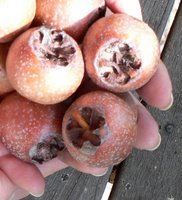
They will blet as they will, each medlar choosing to ripen to delicious rot in its own time.
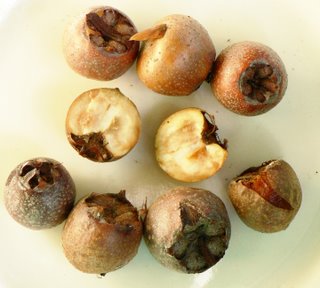
Unripe medlars (such as one cut open above) taste like
snakefruit (another fruit that is outstandingly delicious as well as beautiful) but with added astringency. Unripe medlars were once so famously inedible that this characteristic succoured poets in the days when poets craved easily digestible metaphors.
Much has been written about the proper way to eat a bletted medlar.
Peel a medlar, some say. Others:
Eat it with a spoon.This is a bletted medlar, peeled.

If you peel grapes, then
do peel a medlar.
Otherwise, nip the medlar in its side as if you are a vampire and its tender, turgid, russet-skinned being is a plump neck. Now suck its guts out.
Or squeeze.
This is a bletted medlar, nipped and squeezed.
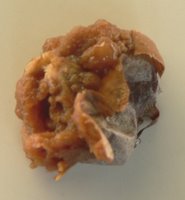
Now savour its complexity.
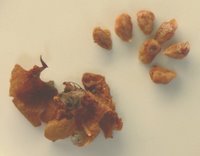
The skin has as much character as the skin of a good yam. And those are the pips. If you can spoon out the flesh of a medlar, you can probably do anything.
Medlars are innies until they overblet, at which point some become outies.
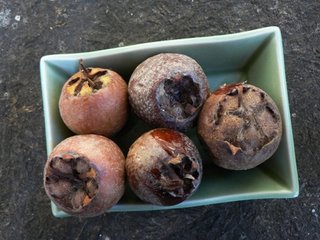
As can be seen above, there is often an anticipatory ooze that exudes from a medlar in just the right state for your pleasure. The ooze is the best candied jelly on this planet.
As for things to do with medlars other than eat them naked as they were born, they have been made into pastes and jellies, and folded into cream to make a fool.
Pastes and
"cheeses" and jellies are delightful, and I love fools, but to my taste, these dressed-up versions slight the beauty of the naked medlar, and more importantly, imply that the medlar is like other modern fruits: bled of individuality. The essence of the medlar, and its charm, is that complex individuality.
Every medlar tastes as it will. It blets in its own time. Its texture and taste are unique and often contrarian. For these reasons, I prefer to eat medlars, guts and all, one by one.
They don't mind company, however.
Citrus becomes them, finely cut skins of mandarin (tangerine) especially, or whole kumquats.
Uncandied, in all cases, as added sugars dull the sweetness in the medlars, and medlars are richly sweet. Walnuts are good company, as is wine, the kind of wine that furs your teeth, as any good wine does. If you make a paste of medlars, I don't recommend adding spice, but if you must, don't, please, use cinnamon, as it makes medlars taste like insipid apple. Cardamom brings out the flavours of date and fig and pear
and spice that all live in each medlar's world of taste.
I once made chocolate-covered medlars. Absolutely disgusting. The medlars revolted in protest, going past the blet into full ferment. They served me right.
~~~~~~~~~~~~~~~~~~~~
Some other posts here on medlars:
Medlars are such characters.
They often appear in my fiction, sometimes in cameos, but in these two stories, they have prominent roles.
17 December 2011 news
"Valley of the Sugars of Salt" has now also been published as an 'ebook single" by infinity plus, available from Amazon UK, Amazon US, and Smashwords. And if you like ebooks, you might prefer to have this story as part of the infinity plus bumper e-dition of Monterra's Deliciosa & Other Tales &)
And let us not forget those mistreated and spurned vegetables
May I recommend, oh friends of unusual discretion, my freshly published "Cardoons!"
"It didn't look cannable. It didn't look boilable. It looked like it could fight monsters, and win."
Yes, this new long story is in a journal of horror, but please don't be put off by that any more than you are from what more than some people think of as the "swollen dead body" aspect of a perfectly bletted medlar. When the world recognises the yen we have for neglected-fruit-and-vegie fiction, we'll get our own genre. In the meantime, we've got to camp rough. Not that there aren't gollops of horror in Cardoons! — but one person's horror is another's irresistible temptation.
 sold in three open-air markets as meat.
sold in three open-air markets as meat.











